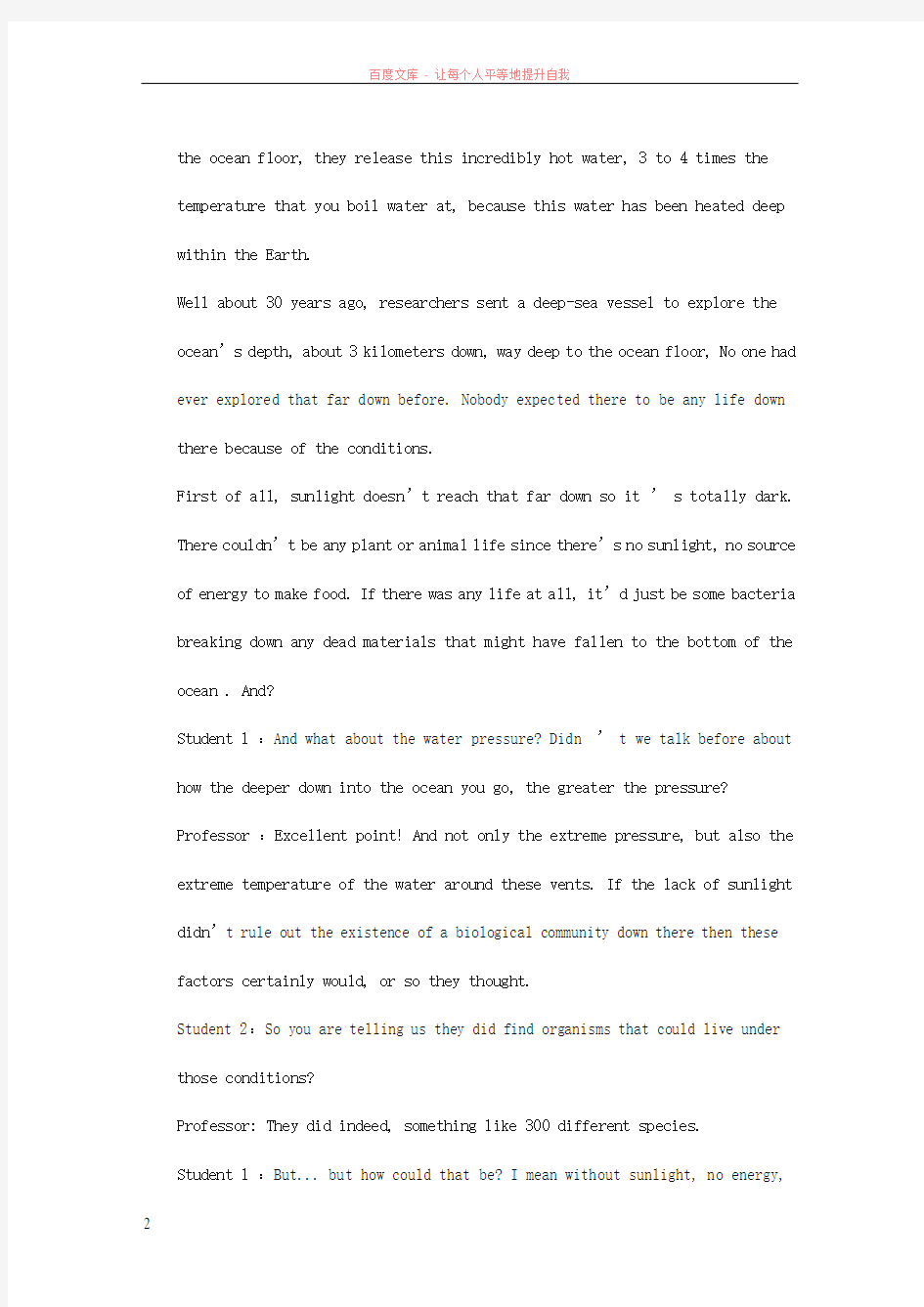托福听力资料托福tpo15听力文本 (2)


【托福听力资料】托福TPO15 听力文本-Lecture 4
众所周知,托福TPO材料是备考托福听力最好的材料。相信众多备考托福的同学也一直在练习这套材料,那么在以下内容中我们就为大家带来托福TPO听力练习的文本,希望能为大家的备考带来帮助。
TPO 15 Lecture 4 Biology
Narrator: Listen to part of a lecture in a biology class.
Professor:
OK. We’ve been talking till now about the two basic needs of a biological
community – an energy source to produce organic materials, you know uh, food for
the organisms, and the waste recycling or breakdown of materials back into
inorganic molecules, and about how all this requires photosynthesis when green
plants or microbes convert sunlight into energy, and also requires
microorganisms, bacteria, to secrete chemicals that break down or recycle the
organic material to complete the cycle. So, now we are done with this chapter of
the textbook, we can just review for the weekly quiz and move on to the next
chapter, right? Well, not so fast. First, I ‘d like to talk about some
discoveries that have challenged one of these fundamental assumptions about what
you need in order to have a biological community.
And, well, there actually were quite a few surprises. It all began in 1977
with the exploration of hydrothermal vents on the ocean floor. Hydrothermal
vents are cracks in the Earth’s surface that occur, well, the ones we are
taiking about here are found deep at the bottom of the ocean. And these vents on
the ocean floor, they release this incredibly hot water, 3 to 4 times the temperature that you boil water at, because this water has been heated deep within the Earth.
Well about 30 years ago, researchers sent a deep-sea vessel to explore the ocean’s depth, about 3 kilometers down, way deep to the ocean floor, No one had ever explored that far down before. Nobody expected there to be any life down there because of the conditions.
First of all, sunlight doesn’t reach that far down so it ’ s totally dark. There couldn’t be any plant or animal life since there’s no sunlight, no source of energy to make food. If there was any life at all, it’d just be some bacteria breaking down any dead materials that might have fallen to the bottom of the ocean . And?
Student 1 :And what about the water pressure? Didn ’ t we talk before about how the deeper down into the ocean you go, the greater the pressure? Professor :Excellent point! And not only the extreme pressure, but also the extreme temperature of the water around these vents. If the lack of sunlight didn’t rule out the existence of a biological community down there then these factors certainly would, or so they thought.
Student 2:So you are telling us they did find organisms that could live under those conditions?
Professor: They did indeed, something like 300 different species.
Student 1 :But... but how could that be? I mean without sunlight, no energy,
no no …
Protessor:
What they discovered was that microorganisms, bacteria, had taken over both functions of the biological community - the recycling of waste materials and the production of energy. They were the energy source. You see, it turns out that certain microorganisms are chemosynthetic - they don’t need sunlight because they take their energy from chemical reactions.
So, as I said, unlike green plants which are photosynthetic and get their energy from sunlight, these bacteria that they found at the ocean floor, these are chemosynthetic, which means that they get their energy from chemical reactions. How does this work?
As we said, these hydrothermal vents are releasing into the ocean depth this intensely hot water and here is the thing, this hot water contains a chemical called hydrogen sulfide, and also a gas , carbon dioxide. Now these bacteria actually combine the hydrogen sulfide with the carbon dioxide and this chemical reaction is what produces organic material which is the food for larger organisms. The researchers had never seen anything like it before.
Student 2 : Wow! So just add a chemical to a gas, and bingo, you ’ ve got a food supply?
Professor
Not just that! W hat was even more surprising were all the large organisms that lived down there. The most distinctive of these was something called the
tube worm. Here, let me show you a picture . The tube of the tube worm is really, really long. They can be up to one and a half meters long , and these tubes are attached to the ocean floor, pretty weird looking, huh?
And another thing, the tube worm has no mouth or digestive organs. So you are asking how does it eat? Well, they have these special organs that collect the hydrogen sulfide and carbon dioxide and then transfer it to another organ, where billions of bacteria live. These bacteria that live inside the tube worms, the tube worms provide them with hydrogen sulfide and carbon dioxide. And the bacteria, well the bacteria kind of feed the tube worms through chemosynthesis, remember, that chemical reaction I described earlier.
